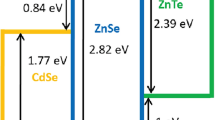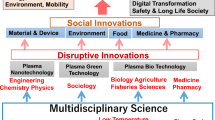Abstract
The synthesis of ammonia from nitrogen-hydrogen plasma prepared using microwave discharge was studied by changing some experimental conditions, such as pressure (260–2600 Pa), power input (30–280 W), and nitrogen-hydrogen mixing ratio [H2/(N2+H2)=0−1.0]. The ammonia yield increased with decreasing pressure and saturated at lower pressures. When the power input and the nitrogen-hydrogen mixing ratio were changed, the maximum yield of ammonia was obtained at the optimum experimental conditions (power input ≈150W; H2/(N2+H2)≈0.75). Amounts of NH, H, and H2 in the plasma also changed by changing the experimental conditions. From the changes in ammonia yield and amounts of NH, H, and H2 by changing the experimental conditions, it is suggested that ammonia molecules are formed by the reaction of NH radicals not only with hydrogen atoms but also with hydrogen molecules. Otherwise, the formation and the decomposition of ammonia would occur simultaneously.
Similar content being viewed by others
References
H. Uyama and O. Matsumoto,Plasma Chem. Plasma Process. 9, 13 (1989).
M. Suzuki, S. Miyazaki, and S. Takahashi,Nippon Kagaku Zasshi 75, 1265 (1954).
E. N. Eremin, A. N. Mal'tsev, and V. L. Syaduk,Russ. J. Phys. Chem. 45, 635 (1971).
G. Y. Botchway and M. Venugopalan,Z. Phys. Chem. Neue Folge 120, 103 (1980).
K. S. Yin and M. Venugopalan,Plasma Chem. Plasma Process.,3, 343 (1983).
M. Touvelle, J. L. Muñoz Licea, and M. Venugopalan,Plasma Chem. Plasma Process. 7, 101 (1987).
O. Nomura, H. Oyama, and Y. Sakamoto,Sci. Paper IPCR 75, 124 (1981).
R. J. Donovan and D. Husain,Chem. Rev. 70, 489 (1970).
D. Smith, N. G. Adams, and T. M. Miller,J. Chem. Phys. 69, 308 (1978).
B. D. Green and G. E. Caledonia,J. Chem. Phys. 77, 3821 (1982).
M. Capitelli and E. Molinari,Plasma Chemistry II, S. Vepřek and M. Venugopalan (eds.), Springer-Verlag, Berlin (1980), p. 71.
R. M. Baddour and R. H. Dundas inThe Application of Plasmas to Chemical Processing, R. M. Baddour and R. S. Timmins (eds.), MIT Press, Cambridge, Mass. (1967), p. 87.
A. V. Phelps, inChemical Reactions in Electrical Discharges, B. D. Blaustein (ed.), American Chemical Society, Washington, D.C. (1969), p. 18.
J. L. Vossen,J. Electrochem. Soc. 126, 319 (1978).
C. M. Ferreira and J. Loureiro,J. Phys. D. Appl. Phys. 17, 1175 (1984).
F. P. Treadwell and W. T. Hall,Analytical Chemistry II. Quantitative, John Wiley and Sons, New York (1961), p. 493.
H. Uyama, T. Uchikura, H. Niijima, and O. Matsumoto,Chem. Lett. 555 (1987).
R. M. Gibbons and R. M. Barrer,Trans. Faraday Soc. 59, 1074 (1958).
M. Venugopalan and S. Vepřek, inPlasma Chemistry IV, S. Vepřek and M. Venugopalan (eds.), Springer-Verlag, Berlin (1983), p. 8.
R. d'Agostino, F. Cramarossa, S. De Benedictis, and G. Ferraro,Plasma Chem. Plasma Process. 1, 19 (1981).
Author information
Authors and Affiliations
Rights and permissions
About this article
Cite this article
Uyama, H., Matsumoto, O. Synthesis of ammonia in high-frequency discharges. II. Synthesis of ammonia in a microwave discharge under various conditions. Plasma Chem Plasma Process 9, 421–432 (1989). https://doi.org/10.1007/BF01083676
Received:
Revised:
Issue Date:
DOI: https://doi.org/10.1007/BF01083676




